The Evolution and Significance of the Great Barrier Reef
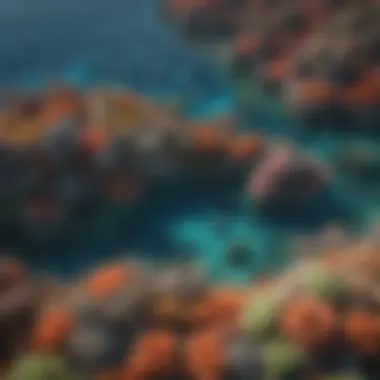

Intro
The Great Barrier Reef, a vast and complex marine ecosystem, has adorned the northeastern coast of Australia for millions of years. Its historical development is not merely a tale of geological processes but also a narrative woven with ecological transformations, human interactions, and conservation efforts. This article aims to chart the intricate evolution of this natural wonder, highlighting the multifaceted aspects that have shaped it.
Research Overview
Key Findings
The reef's formation began around 20 million years ago, resulting from geological and biological processes. It has developed through various stages, influenced by climate shifts, sea level changes, and coral growth patterns.
Exploring the reef's ecological significance reveals its role as a habitat for diverse marine life. The interactions existing within its ecosystem are critical for maintaining biodiversity and supporting global ecological health.
Historically, human engagement with the reef underscores a complex relationship, from early exploration to modern tourism, leading to both appreciation and environmental challenges.
Study Methodology
This article utilizes a historical analysis approach, combining geological studies with ecological research. Sources include academic journals, environmental reports, and historical accounts, providing a well-rounded view of the reef’s progress over the years.
Background and Context
Historical Background
The Great Barrier Reef originated from a period of geological activity, marked by the uplift of land and subsequent sea level rises. The coral structures began forming as the oceans warmed, creating a unique habitat. Over time, the biodiversity flourished, making it a global biodiversity hotspot. Different species of corals, fish, and marine organisms emerged and adapted to this ever-evolving environment.
Current Trends in the Field
Today, the reef faces severe threats from climate change, pollution, and human activities. The increasing water temperatures lead to coral bleaching, profoundly impacting its ecological integrity. Conservation efforts are underway, but challenges persist. Current trends indicate a focus on scientific research and community engagement to bolster preservation efforts.
"The Great Barrier Reef is not only a natural marvel but also a fundamental component of global ecological health. Its preservation is essential for biodiversity and human well-being."
As we unfold this narrative, we will delve deeper into the geological formation, cultural significance, and ongoing conservation challenges associated with the Great Barrier Reef, offering an insightful glimpse into its past and present.
Geological Formation
The geological formation of the Great Barrier Reef is crucial to understanding its current structure and ecological significance. This section explores the formation processes that shaped the reef, delves into its origins, and examines how historical events influenced its development. The geological underpinnings provide a context for the biodiversity, cultural importance, and the ongoing conservation work surrounding the reef.
Origins of the Reef
The Great Barrier Reef began forming approximately 500,000 years ago during the Pleistocene epoch when sea levels fluctuated dramatically. These fluctuations allowed for the accumulation of limestone deposits, forming the vast coral structures we see today. The primary contributors to this formation included coral polyps, tiny marine animals that build hard skeletons, which later form reefs.
The interplay of various environmental factors also played a significant role in the reef's inception. Changes in ocean temperature and salinity, along with nutrient availability, created ideal conditions for coral growth. Over time, various species of coral specialized and adapted to the local environment, establishing a diverse ecosystem. The origins of the reef show a fascinating relationship between geological activity and biological evolution, which constructed the basis for what is now a UNESCO World Heritage site.
Timeline of Development
The timeline of the Great Barrier Reef's development is marked by significant geological and biological events. Key milestones include:
- Post-Pleistocene Era: After the last Ice Age, rising sea levels submerged land masses, creating suitable areas for coral growth.
- Holocene Period: During this time, which started about 11,700 years ago, the reef expanded rapidly. The warmth of the period allowed coral colonies to thrive, forming barrier reefs.
- Recent Centuries: Human activities starting in the late 18th century, such as exploration and tourism, began to alter the natural development of the reef.
By studying these phases, we can derive insights into the resilience and adaptation of marine ecosystems. Each era provided unique challenges and opportunities, influencing the reef's current state. Moreover, understanding this timeline can inform effective conservation strategies for the reef's future.
Influence of Sea Level Changes
Sea level changes have been a persistent factor affecting the Great Barrier Reef's formation and growth. Over the millennia, sea levels have fluctuated due to climatic changes. These variations often resulted in the flooding of coastal areas and land exposure, leading to shifts in the habitat for coral reefs.
Two primary influences stand out:
- Eustatic Changes: These are global sea level changes caused by melting ice caps and thermal expansion of seawater. They significantly impact the distribution and types of corals in the reef.
- Isostatic Rebound: The rise of land previously covered by ice can also alter local sea levels. This has direct implications for coral habitats and their recovery patterns.
Understanding both forces helps clarify why certain sections of the Great Barrier Reef are more resilient than others and how they may respond to future changes. Knowledge of these influences is essential for predicting the reef's behavior in the face of ongoing climate change.
Biodiversity of the Reef
Biodiversity within the Great Barrier Reef is not just a byproduct of its rich ecosystem; it is essential for the health and sustainability of marine life. The diversity of species contributes to the ecological balance and resilience of the reef system. Healthy ecosystems support various marine species, impacting everything from food webs to nutrient cycling. Understanding the biodiversity of the reef helps emphasize its importance not just for local environments but for global ecological health.
Marine Species Variety
The Great Barrier Reef hosts an astonishing variety of marine species. Estimates suggest that there are over 1,500 species of fish, around 400 kinds of coral, and numerous other marine organisms, including sea turtles, dolphins, and various species of sharks. This variety allows for complex interactions and relationships within the habitat, enhancing overall ecosystem productivity. Additionally, the presence of such a diverse array provides various ecological services, including tourism, fisheries, and research opportunities, which are vital for local communities and the economy.
Ecosystem Interactions
Interactions among species within the Great Barrier Reef form intricate ecological networks. For instance, coral provides habitat for fish, while fish contribute to the health of coral by removing algae. This mutualistic relationship is crucial for maintaining coral reef ecosystems. Predator-prey dynamics also play a significant role. Higher trophic levels, like sharks, maintain fish populations, preventing overgrazing on coral. Other interactions include competition for space and resources, which shape community composition. Understanding these relationships is vital for conservation efforts, as disruptions may lead to unintended consequences.
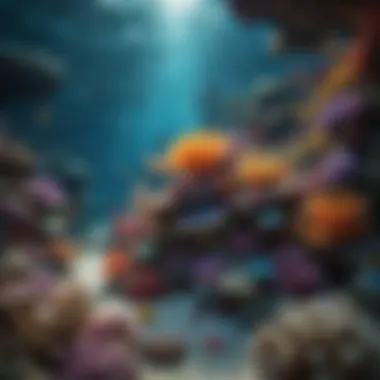
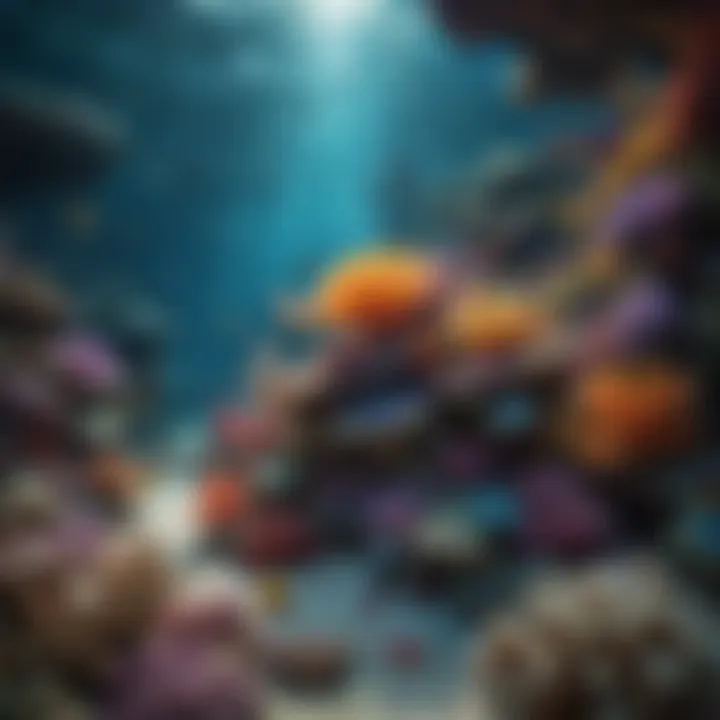
Habitat Types
The Great Barrier Reef is composed of several distinct habitat types, each supporting unique communities of organisms. These include:
- Coral Reefs: The primary feature, rich in biodiversity, providing shelter and food.
- Seagrass Beds: Vital for many marine species as breeding and feeding grounds, they also play a role in carbon storage.
- Mangrove Forests: These coastal ecosystems contribute to shoreline protection and support diverse wildlife.
Each habitat type contributes to the overall health and functioning of the reef system, underscoring the need for a holistic approach to conservation. Understanding these habitats aids in identifying vulnerable areas and prioritizing them for protection.
"The Great Barrier Reef is a living system, where biodiversity plays a crucial role in its resilience and sustainability."
Overall, the biodiversity of the Great Barrier Reef is foundational for its ecological integrity. Protecting this diversity is essential for maintaining the health of not just the reef but the broader marine environment.
Cultural Significance
The Great Barrier Reef holds profound cultural significance that extends beyond its biological and ecological attributes. This noteworthy ecosystem serves as a living testament to the interconnection between humanity and nature, especially through the lens of Indigenous peoples. Their traditions, practices, and beliefs are tightly interwoven with the reef, offering a rich narrative that encompasses respect, sustainability, and cultural identity.
Indigenous Peoples and the Reef
Indigenous communities, such as the Torres Strait Islanders and the Aboriginal peoples of Australia, have a deep-rooted relationship with the Great Barrier Reef. For thousands of years, these groups have relied on the sea for sustenance, employing traditional fishing techniques that have been handed down through generations. This connection manifests not only in their livelihood but also in their cultural practices and spiritual beliefs.
Understanding the significance of the reef involves recognizing Indigenous customs and narratives about the land and waters. For instance, various rituals and stories emphasize the importance of conservation and respect for marine life. These Indigenous perspectives highlight the reef as a sacred place, where every creature holds value. As oral traditions and cultural practices evolve, they retain elements of environmental stewardship, showcasing a holistic approach to resource management.
Historical Exploration
Historical exploration of the Great Barrier Reef has seen its share of notable figures and expeditions. The earliest European contact dates back to the 17th century, when explorers such as Willem Janszoon first navigated its waters. Over time, more adventurers and scientific minds sought to map and understand this vast marine environment. A pivotal moment came in 1770, when Captain James Cook charted much of the reef, opening it up to further exploration and eventual exploitation.
These encounters brought to light not only the natural resources available but also introduced myriad impacts, both positive and negative. Early exploration led to the documentation of various species but also marked the beginning of colonial interests that sought to extract resources without regard for the impacts on Indigenous cultures and the environment.
Folklore and Stories
Folklore and stories surrounding the Great Barrier Reef are essential in preserving its cultural significance. These narratives often include creation myths and legends that describe the genesis of the reef and its inhabitants. For instance, stories of ancestral beings who shaped the landscape and the sea are prominent among Indigenous cultures.
Such tales serve multiple purposes: they educate younger generations about the reef's ecology, moral conduct, and communal values. Additionally, they illustrate the rich tapestry of human experience associated with this natural wonder, fostering a sense of pride and ownership among Indigenous peoples.
Scientific Exploration
Scientific exploration of the Great Barrier Reef has been a crucial element in understanding its complex ecosystem and overarching significance within marine biology. Over the years, researchers have endeavored to uncover the intricacies of this natural wonder, revealing how its formation influences biodiversity, ecosystems, and even human activity. This section will discuss early studies, modern methodologies, and the contributions made to marine biology, underlining their importance in conservation efforts and ecological understanding.
Early Studies and Discoveries
The early studies of the Great Barrier Reef laid a foundation for future research and exploration. In the late 18th century, explorers like Captain James Cook began to chart these waters, noting the diverse marine life and the vibrant coral structures. Their observations were essential in creating initial maps and assessments of the reef's geographical layout.
In the subsequent decades, scientists such as Joseph Banks and others contributed to understanding the different species that inhabited the reef. Collections of specimens were essential in classifying marine organisms, allowing researchers to document biodiversity accurately. These early studies fostered appreciation for the reef's ecological role, prompting further inquiry into its biological and geological features.
Modern Research Methods
With advances in technology, modern research methods have revolutionized the study of the Great Barrier Reef. Techniques like remote sensing, underwater drones, and genetic analysis provide researchers with tools to collect data more efficiently than ever. Today, scientists deploy autonomous underwater vehicles to explore inaccessible areas, gathering real-time data on coral health and marine biodiversity.
Moreover, satellite imaging enables a macro view of the reef's environment, tracking environmental changes over time. Presently, interdisciplinary approaches unite marine biology, ecology, and climate science, facilitating collaboration among various fields. This modern toolkit is not only about collecting data but also ensuring its application in conservation strategies and environmental policy.
Contributions to Marine Biology
The extensive research on the Great Barrier Reef has far-reaching implications in the field of marine biology. Throughout the years, the reef has served as a living laboratory for studying coral reef ecosystems worldwide. By understanding local conditions and species, scientists have drawn parallels to global marine environments, which benefit from these observations.
Key contributions include insights into coral resilience under changing temperature and ocean acidification conditions. Studies based on the reef's response to stressors have provided a clearer picture of coral health sustainability, aiding in the development of preservation initiatives.
In summary, the scientific exploration of the Great Barrier Reef has been fundamental in framing our comprehension of marine systems. The historical studies set the stage, modern methodologies improve precision, and contributions to marine biology inspire necessary conservation efforts. As we move forward, ongoing research will be pivotal to understanding, protecting, and appreciating this vital ecological treasure.
"Understanding the reef is not simply about conserving a marine ecosystem; it's about sustaining our planet's health."
This exploration ensures a holistic approach towards reef conservation, aligning ecological, social, and economical aspects.
Conservation Efforts
Conservation efforts are critical for maintaining the health and integrity of the Great Barrier Reef. These efforts encompass various strategies aimed at protecting the reef from environmental threats and mitigating human impacts. The reef is not just a remarkable natural wonder; it is also vital for biodiversity, economy, and cultural identity. Effective conservation measures are essential to ensure that future generations can experience this unique ecosystem.
Legislation and Protection
Legislation plays a key role in conservation. In Australia, several laws and regulations specifically target the protection of the Great Barrier Reef. The Environment Protection and Biodiversity Conservation Act 1999 is one such piece of legislation. It aims to protect the reef's ecological integrity, and its provisions are critical for managing development activities along the coast and ensuring sustainable practices.
In addition, the Great Barrier Reef Marine Park Act 1975 established a zoning plan for the marine park, which regulates activities such as fishing, tourism, and shipping. These laws enable authorities to monitor compliance and impose penalties for illegal activities that harm the reef. Continuous updates to these regulations address emerging threats such as climate change and fishing pressures.
Community Initiatives
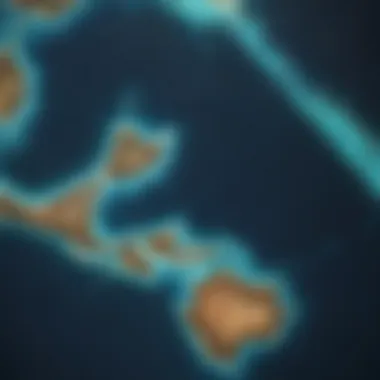

Community involvement is a cornerstone of effective conservation. Local groups and organizations engage in various initiatives to promote sustainability and protect the reef. For example, grassroots programs often focus on educating the public about the importance of the reef and how individuals can contribute to its preservation.
Local initiatives include:
- Beach clean-ups: These activities not only remove debris but also raise awareness about pollution.
- Citizen science projects: Residents can participate in monitoring coral health or tracking marine species, contributing valuable data to researchers.
- Sustainable practices: Encouraging local businesses to adopt eco-friendly practices helps reduce the reef's ecological footprint.
Through these efforts, communities strengthen their connection to the reef and foster a culture of stewardship.
Challenges in Preservation
Despite ongoing efforts, the preservation of the Great Barrier Reef faces numerous challenges. Climate change remains the most pressing issue. Rising ocean temperatures lead to coral bleaching, which weakens the reef's resilience.
Additionally, pollution from agricultural run-off and urban development further exacerbates the degradation of this vital ecosystem. Overfishing and destructive fishing practices can deplete fish populations and disrupt the ecological balance. These challenges call for a multifaceted approach, requiring collaboration among governments, communities, and scientists.
"The Great Barrier Reef is a fragile ecosystem that requires immediate action and continued commitment from all of us to protect its future."
For further reading on conservation measures, visit the Wikipedia page or explore resources at Britannica for detailed insights.
Global Environmental Impacts
Understanding the global environmental impacts related to the Great Barrier Reef is vital for several reasons. The reef is not just a local treasure; it contributes to global biodiversity and plays a crucial role in ecological resilience. The degradation of this natural wonder has broader implications that resonate across continents, making it essential to study the factors affecting its health.
Effects of Climate Change
Climate change stands as a prominent threat to the Great Barrier Reef. Rising sea temperatures lead to stress on coral structures. This stress manifests in various ways, including increased susceptibility to diseases and reduced capacity for growth. Moreover, acidification of oceans caused by elevated CO2 levels complicates coral calcification, impairing their natural defenses.
The frequency of severe weather events, such as cyclones, has also escalated. These events disrupt marine habitats and can lead to physical damage of coral formations. According to research, even a rise of 1-2 degrees Celsius can cause substantial coral bleaching, which might have lasting consequences on marine life.
Coral Bleaching Events
Coral bleaching is a significant indicator of reef health and is often a direct consequence of climate change. During these events, corals expel the symbiotic algae known as zooxanthellae, which are integral to their color and nutritional needs. Without these algae, corals turn white and become vulnerable to mortality.
Major bleaching events occurred in 1998, 2002, and 2016, impacting vast sections of the reef. These occurrences serve as a stark reminder of how delicate the coral ecosystem is. Recovery from bleaching can take years or even decades, which makes intervention and conservation efforts urgent. Research indicates that while some species may adapt, many are at risk due to accelerated environmental changes.
"The Great Barrier Reef is a critical indicator of the health of the world's oceans. When it suffers, we lose a part of our natural heritage that provides ecological balance."
Pollution and Human Activity
Pollution poses another dire challenge to the Great Barrier Reef. Land-based runoff, particularly from agriculture and urban areas, carries sediments and nutrients into the ocean. Excess nutrients can lead to algal blooms that deprive corals of essential light and nutrients, further impairing their growth.
Plastic waste is also a growing concern. Marine debris not only physically harms marine animals but can also introduce toxins into the ecosystem. The tourism industry, while economically significant, may contribute to pollution if not managed sustainably. Activities such as boating, fishing, and careless waste disposal lead to long-term damage to coral reefs.
Addressing these issues requires not only a commitment at the local level but also international cooperation. \nGlobal efforts, including legislation and grassroots movements, are essential to preserve this critical ecosystem and ensure that the Great Barrier Reef can continue to thrive in a changing world.
Tourism and Its Influence
The Great Barrier Reef is not only a natural marvel but also a significant driver of tourism in Australia. This section covers the role of tourism in shaping public perception and policy regarding this UNESCO World Heritage site. Understanding how tourism affects the reef is essential in discussions about conservation, economic dependence, and sustainable practices.
Growth of Reef Tourism
The growth of reef tourism has been remarkable over the past few decades. As awareness of the reef's beauty spread globally, more people sought to experience its wonders firsthand. In 2019, nearly 3 million visitors came to the Great Barrier Reef, contributing significantly to local economies. Tour operators offer snorkeling, diving, and boat tours, which allow visitors to interact with marine life.
However, this boom has raised concerns. Increased foot traffic can lead to habitat degradation. Coral reefs are delicate ecosystems, sensitive to disturbances. Despite their resilience, repeated human activity can weaken their structure.
Economic Considerations
The economic impact of reef tourism is substantial. Local communities depend on this industry for income and employment. In the Cairns region, tourism-related activities support thousands of jobs. Economic benefits include:
- Revenue for local businesses
- Investment in infrastructure
- Job creation in hospitality and recreation sectors
Yet, dependency on tourism poses risks. Economic downturns, like those caused by the COVID-19 pandemic, revealed vulnerabilities. Without diversification, communities may suffer. Balancing tourism revenue with conservation needs is critical.
Balancing Conservation with Access
The challenge lies in balancing tourism access with the need to conserve the reef. Restrictions have been implemented to minimize damage. For example, the Great Barrier Reef Marine Park Authority enforces zoning regulations. These guidelines help in protecting sensitive areas while still allowing tourism to flourish.
Some key strategies include:
- Regulating visitor numbers
- Implementing environmental education programs
- Promoting sustainable tourism practices
The future of the Great Barrier Reef depends on this balance. Ensuring that visitors can continue to explore its beauty while protecting its ecosystems is paramount. Community engagement in conservation efforts further enhances this balance.
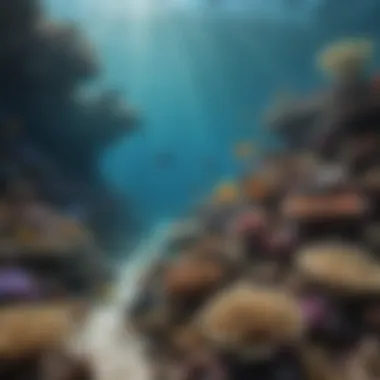

"The future of the Great Barrier Reef relies heavily on sustainable practices that both allow for tourism and protect the biodiversity present in the reef."
Understanding the complexities of tourism's impact on the Great Barrier Reef is vital. With a thoughtful approach, it is possible to enjoy the benefits of tourism while ensuring the preservation of this natural treasure for future generations.
Future Prospects
The future of the Great Barrier Reef remains a critical area of study due to the numerous challenges and opportunities that lay ahead. Climate change, pollution, and overfishing continue to threaten the delicate balance of this complex ecosystem. However, recent years have seen innovative strategies and technological advancements that foster optimism. This section delves into the important elements of future prospects, showcasing the benefits and considerations essential for sustainable management of the Reef.
Innovative Conservation Strategies
One of the promising paths for the Great Barrier Reef lies in innovative conservation strategies. Organizations and researchers are now employing cutting-edge approaches to enhance reef resilience. These strategies include:
- Restoration Projects: Initiatives aimed at restoring degraded areas of the reef are being developed, focusing on coral planting and habitat creation.
- Genetic Research: Scientists are exploring genetic enhancements to increase coral resilience against stressors like temperature changes and bleaching.
- Community Engagement: Local communities are increasingly involved in conservation efforts, fostering stewardship and knowledge-sharing initiatives.
By integrating science with local knowledge, these strategies can create effective frameworks for recovery and long-term sustainability of the reef. The role of community partnership in these efforts cannot be overstated, as it enables more robust, inclusive decision-making that is crucial for success.
Role of Technology in Monitoring
Technological advancements play a significant part in the management and protection of the Great Barrier Reef. Remote sensing, underwater drones, and artificial intelligence are integral tools now in use for monitoring health and changes in the reef. Key aspects include:
- Data Collection: Drones can gather data on coral health, water quality, and marine life populations, providing crucial insights.
- Artificial Intelligence: AI algorithms analyze these vast data sets, identifying patterns that may indicate reef stress or degradation.
- Real-Time Monitoring: Technology enables real-time assessments of environmental changes, allowing for immediate response measures where necessary.
Such technological applications ensure that researchers can make informed decisions, thereby improving conservation efforts overall.
Global Cooperation and Policy Development
The Great Barrier Reef's future relies heavily on international cooperation and effective policy development. As a World Heritage Site, the reef's health has global implications, necessitating a unified response. Important considerations include:
- International Agreements: Promoting agreements aimed at reducing carbon emissions globally can mitigate climate change effects on the reef.
- Shared Research Initiatives: Collaborative research among countries and institutions fosters innovation and shares best practices with broad-reaching impact.
- Policy Frameworks: Developing comprehensive policies that balance economic interests with environmental sustainability is essential. This involves engaging stakeholders from various sectors, including tourism, fishing, and local communities.
Ultimately, concerted global efforts can reinforce local actions, leading toward a sustainable future for the Great Barrier Reef.
"It is only through our collective efforts that we can ensure the Great Barrier Reef survives for generations to come."
Understanding these aspects empowers stakeholders to act effectively, making informed decisions that shape the Reef's future. As we reflect on the developing prospects, it is evident that a proactive stance is vital for safeguarding this irreplaceable ecosystem.
Case Studies
Successful Restoration Projects
Successful restoration projects are vital to rebuilding the health of the Great Barrier Reef. One notable example is the Coral Gardening Initiative. This project involves growing coral fragments in nurseries and then transplanting them back into degraded areas. Studies show that areas restored through this method exhibited higher biodiversity and resilience compared to their non-restored counterparts.
Another example is The Reef Trust, which focuses on funding major restoration efforts across Queensland. This initiative supports activities such as reef monitoring and the rehabilitation of nearby coastal ecosystems. Together, these projects highlight the efficacy of targeted restoration efforts in combating the degradation of coral systems.
Failures and Lessons Learned
Not all restoration attempts yield the desired outcomes. The Crown-of-Thorns Starfish Control Program faced significant challenges. While initially intended to reduce coral predation, the efforts often led to insufficient results and resource wastage. Similarly, some replanting endeavors were hampered by poor survival rates due to environmental stressors like climate change and pollution.
These failures emphasize several key lessons:
- Understanding local ecology is paramount before initiating restoration.
- Adaptive management practices should be employed to adjust strategies based on emerging data.
- Collaboration with local communities is essential to enhance the efficacy of restoration projects.
Research Collaborations
Research collaborations have greatly enhanced our understanding of the Great Barrier Reef. Institutions such as James Cook University work closely with government bodies and non-profits to conduct interdisciplinary studies on reef health. Their work includes investigating coral resilience and developing innovative monitoring technologies, ensuring a comprehensive approach to reef conservation.
Collaborative projects often emphasize the involvement of indigenous knowledge. This approach not only enriches the research but also strengthens the cultural connection to the reef. Engaging diverse stakeholders in research efforts leads to more sustainable and informed management strategies.
“Sustainable management of the Great Barrier Reef relies heavily on partnerships among scientists, local communities, and governing bodies.”
Summary and Ending
The conclusion is a crucial part of any article, especially one that examines the Great Barrier Reef from its geological formation to its cultural significance and the challenges it faces today. This section synthesizes the content presented earlier, allowing readers to grasp the full spectrum of information comprehended. It emphasizes the interconnectedness of geological, ecological, and cultural factors in understanding this natural wonder.
Recapitulation of Key Points
The Great Barrier Reef, as explored, presents an extensive timeline of development. Several points stand out:
- Geological Origins: Understanding how the reef was formed reveals its dynamic climate and geological conditions.
- Biodiversity: The richness of marine life establishes the reef's importance in global ecology, highlighting various species and their interactions.
- Cultural Significance: The indigenous peoples’ connection and modern explorations illustrate the reef's role in human history and culture.
- Scientific Exploration: Early and modern studies have advanced marine biology and offered insights into ecosystems.
- Conservation Efforts: Efforts and legislation show the ongoing struggle to protect the reef amid numerous threats, including climate change.
- Future Prospects: Innovative techniques and global collaboration will be vital in ensuring the reef's survival.
Every point outlined contributes to a holistic understanding of the reef's significance.
Implications for Future Research
Future research on the Great Barrier Reef must consider various dimensions. It is necessary to:
- Investigate the impact of climate change at finer scales, focusing on specific coral species and their resilience.
- Explore community-based initiatives involving indigenous voices, ensuring ethical participation in preservation efforts.
- Examine the economic aspects of sustainable tourism, assessing possible benefits against environmental impacts.
Addressing these aspects can form a basis for a wider understanding of marine conservation.







